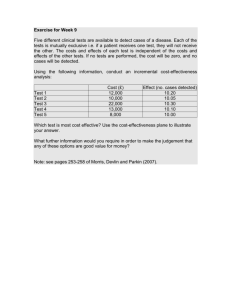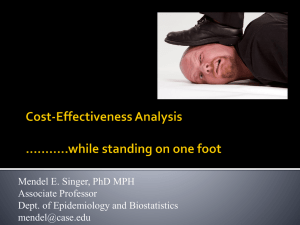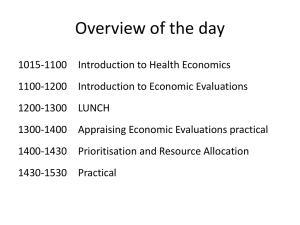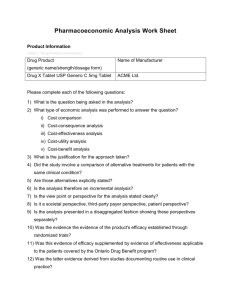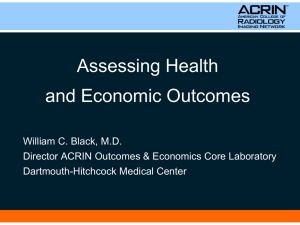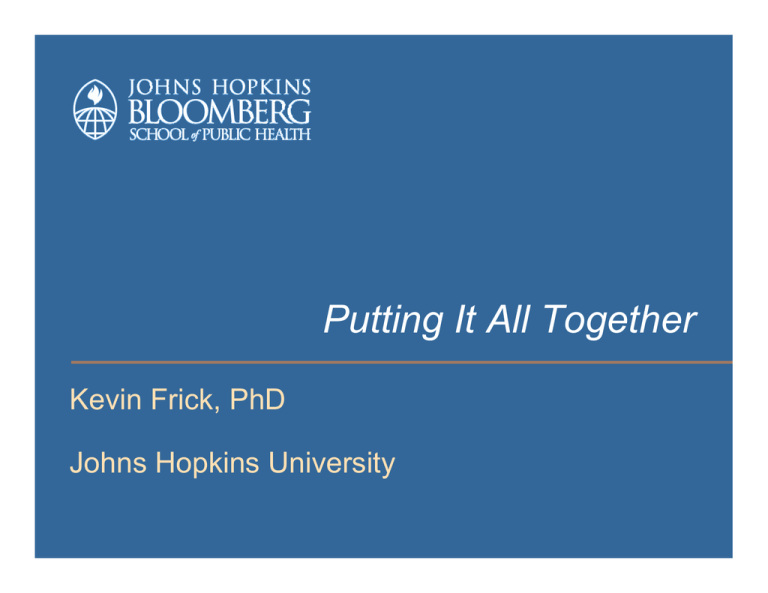
Putting It All Together
Kevin Frick, PhD
Johns Hopkins University
Section A
Putting Cost-Effectiveness in Context
Cost-Effectiveness and Policy
Cost-effectiveness is rarely the only criterion
for policy
Must consider objective of policy maker
In some policy contexts, cost-effectiveness is
explicitly not considered
Appears to be used more widely in cases in
which resources are more constrained
3
Cost-Effectiveness and Practice
Practice decisions should ultimately be left to
the provider and patient considering what is
best for the patient
Continued
4
Cost-Effectiveness and Practice
Elements of cost-effectiveness may play a role
Ë CEA could affect what services covered
Ë Costs may be a consideration for the
patient, in particular the distribution of
costs may be a consideration
Continued
5
Cost-Effectiveness and Practice
Elements of cost-effectiveness may play a role
Ë Outcomes are definitely of interest
Ë Should not be making individual
treatment decisions based on what is
most cost-effective for society unless
insurer has chosen to cover only the
service that is most cost-effective for
society
6
Cost-Effectiveness and the Patient
Patient may be interested in costeffectiveness from their own perspective
The patient may consider only effects
Patients may not understand that “expected”
costs and “expected” effects are used in the
analysis
Repeating an idea, an individual patient’s
treatment should not be based on general
cost-effectiveness results
7
Disability Adjusted Life Years
QALYs are one of several measures that
summarize morbidity and mortality
Disability adjusted life years give higher
scores for time spent with disability and lower
scores for time spent without disability
Ë Refer to DALYs averted instead of
QALYs gained
Continued
8
Disability Adjusted Life Years
QALYs are one of several measures that
summarize morbidity and mortality
Disability adjusted life years give higher
scores for time spent with disability and lower
scores for time spent without disability
Ë Refer to DALYs averted instead of
QALYs gained
Continued
9
Disability Adjusted Life Years
Scores based on person-tradeoff methodology
Used in global calculations more than QALYs
Supposed to be independent of cultural
context
10
Person Tradeoff
Ask how a respondent feels about treating
others or preventing a condition for others
rather than how he feels a condition would
affect himself
Ask about the number needed to be cured of a
disability to be of equal value to saving healthy
individuals from death
Continued
11
Person Tradeoff
Ask about the number of individuals who
would need to live an extra year with a
disability to be of equal value to having a
healthy individual alive for another year
12
Person Tradeoff and Consistency
The two methods described should yield
logically consistent, although not identical,
responses
An early exercise using the PTO method
Ë People responded to both methods
Ë People were given data on what each
answer would imply the other should be
Continued
13
Person Tradeoff and Consistency
An early exercise using the PTO method
Ë Individuals reconcile their two
responses
Ë Meet in small groups to come to
consensus
Has shown great consistency across groups
Ë Is it due to PTO being better or the
rigorous process of consensus
building?
14
Handicap Adjusted Life Years
Base weights on handicap rather than
disability or quality of life
Handicap is at the end of a continuum
Ë Disease
Ë Impairment
Ë Disability
Ë Handicap
Used in only one or two studies
15
Reaching a Unified Outcome
There is no unified outcome for costeffectiveness studies at present
Ë Different societies and decision makers
within the societies care about different
aspects of health outcomes
Both DALYs and QALYs are used frequently
Continued
16
Reaching a Unified Outcome
Difficulty linking outcomes to QOL
Ë Nursing home residents with severe
cognitive impairments are an example
Ë Could stick with clinical outcomes
Ë Could do CBA from health system
perspective without trying to link to a
clinical or quality of life outcome
17
Section B
Understanding Limitations
What Is a QALY Really Worth?
Is there a maximum amount that society is
willing to pay for a QALY?
Ë Should there be?
Ë Should programs be compared to this
maximum?
Ë How often should the maximum be
updated?
Continued
19
What Is a QALY Really Worth?
Is there a maximum amount that society is
willing to pay for a QALY?
Ë Should there be?
Ë Should programs be compared to this
maximum?
Ë How often should the maximum be
updated?
Continued
20
What Is a QALY Really Worth?
Could we use a dollar value of QALYs to
convert results to cost-benefit?
Should the value be the same for everyone?
Continued
21
What Is a QALY Really Worth?
Could we use a dollar value of QALYs to
convert results to cost-benefit?
Should the value be the same for everyone?
22
Opportunity Costs vs. Not Produced Goods
and Services
Sometimes indirect costs focus on the entire
opportunity cost of time regardless of what the
person would have been doing
Some people want to reflect only goods and
services that are not produced
Ë Friction cost
Continued
23
Opportunity Costs vs. Not Produced Goods
and Services
Always include cost of advertising,
interviewing, hiring, and training
Ë Start of study and at intervals
throughout
Difference in concept in what should be
included in the economic cost of being ill and
missing work
Continued
24
Opportunity Costs vs. Not Produced Goods
and Services
Always include cost of advertising,
interviewing, hiring, and training
Ë Start of study and at intervals
throughout
Difference in concept in what should be
included in the economic cost of being ill and
missing work
25
Societal Values vs. Local Values
Recommendation is to use utilities for
conditions or instruments with algorithms that
are based on societal preferences
Ë Local values may differ
Ë Values may differ among demographic
groups
Ë Individual values may differ
Ë General population may not understand
the condition and its implications
26
Methods of Ascertaining Health Care Costs
Costs calculations can use a variety of methods
Ë Value of resources
Ë Contractually allowed amount
Ë Charges adjusted by the cost to charge
ratio
Ë Allowed amount for general case of
condition rather than specific case under
study
Results are not necessarily identical
27
y
Instruments
Multiple studies on different health utility
instruments
Ë Different absolute values
Ë Different magnitudes of impact for a
given condition
Ë Different rank ordering
Continued
28
y
Instruments
Consistency in person tradeoff exercise for
DALY measurement may suggest ways to
obtain values that are more consistent
No two instruments ask about the same
characteristics of an individual
29
Differences in Cost-Effectiveness
Results for Subpopulations
A cost-effectiveness analysis may have one
implication for society as a whole and different
implications for demographic subgroups that
face different risks
Making policy from a single result may be
difficult
Making policy from different results may
suggest discrimination
30
What if There Are “Winners” and “Losers?”
Economic principles suggest that if there are
winners and losers, the winners may be able
to compensate the losers
Ë Potential Pareto Improvement
Health cannot be transferred among
individuals
Can a program be supported politically if there
are winners and losers?
31
Section C
Future of Cost-Effectiveness Analysis
Pragmatism, Theory, and the Way People
Really Think
The recommendations of the Panel on CostEffectiveness in Health and Medicine were
based on pragmatism and theory
Continued
33
Pragmatism, Theory, and the Way People
Really Think
Some recent methodological work has
focused on trying to get cost-effectiveness
analysis to resemble how people think
Ë Less grounded in theory
Ë Make tradeoffs between trying to stay
true to theory and what theory suggests
about decision making and trying to
make analyses appear to reflect the
way the population actually thinks about
decision making
34
Alternatives to QALYs
Different metrics
Ë Have discussed DALYs and HALYs
Attempt to get results that reflect the
distribution of gains
Ë Fair innings
x Weight QALYs gained more
heavily for those who have
experienced fewer QALYs before
the intervention
Continued
35
Alternatives to QALYs
Different metrics
Ë Have discussed DALYs and HALYs
Attempt to get results that reflect the
distribution of gains
Ë Fair innings
x Weight QALYs gained more
heavily for those who have
experienced fewer QALYs before
the intervention
36
Generalized Cost-Effectiveness Analysis
Cost-Effectiveness Analyses in Developed
Economies
Most focus on changes that could occur but
assume that the status quo will remain unless
it has been shown to be detrimental
Continued
37
Generalized Cost-Effectiveness Analysis
Generalized cost-effectiveness analysis asks
what would happen if the status quo were
taken away
Ë Suggested by a policy evaluation team
at the World Health Organization
Ë Good question for system reform
Ë Need to have expectation that the
status quo could be dropped
38
Valuation of Effects
For Individuals Outside the Target
Population
Most studies focus on valuing results for the
target population of the intervention
Ë In spite of the fact that externalities are
a major motivation for public activities
Ë Should we look at only monetary effects
for those outside the target population?
Continued
39
Valuation of Effects
For Individuals Outside the Target
Population
Most studies focus on valuing results for the
target population of the intervention
Ë Should we also consider the quality of
life effects for those outside the target
population?
Ë Do we need different quality of life
instruments for those outside the target
population?
40
Long-Term Cost-Effectiveness
Cost-effectiveness studies are often based on
data over a relatively short period of time
Draw on combination of primary data from a
study like a randomized trial and secondary
data from other randomized trials or other
epidemiological studies
Often involve significant modeling
Ë Requires many assumptions
41
What Can Be Compared?
Different ways of treating a particular disease
or preventing a particular condition
Ë Cost-benefit, cost-utility, costeffectiveness
Different ways of treating a particular
population affected by different diseases
Ë Cost-benefit, cost-utility, costeffectiveness focusing on life-years only
Continued
42
What Can Be Compared?
Treating different populations
Ë Cost-benefit, cost-utility
Copyright 2005, The Johns Hopkins University and Kevin Frick. All rights reserved. Use of these materials permitted only in accordance with license rights granted.
Materials provided “AS IS”; no representations or warranties provided. User assumes all responsibility for use, and all liability related thereto, and must
independently review all materials for accuracy and efficacy. May contain materials owned by others. User is responsible for obtaining permissions for use from
third parties as needed.
43

